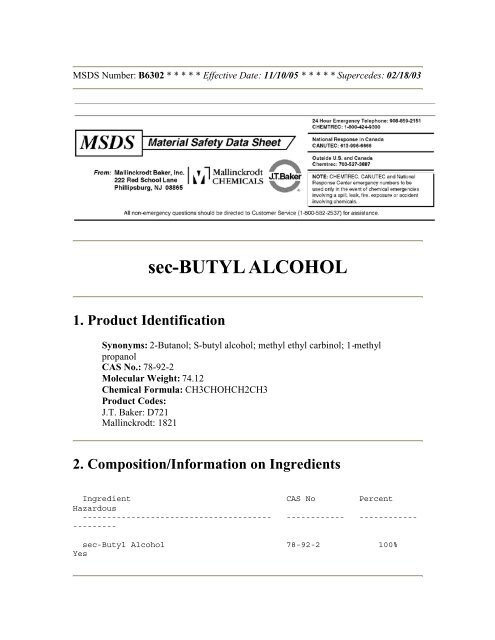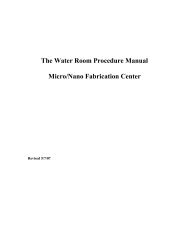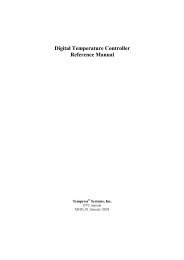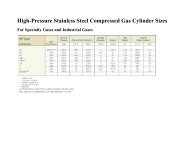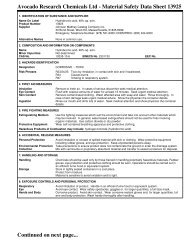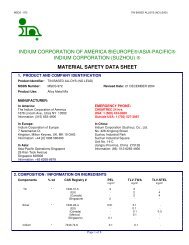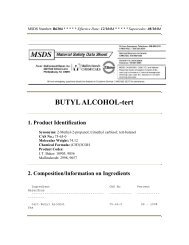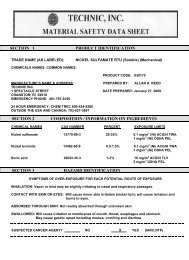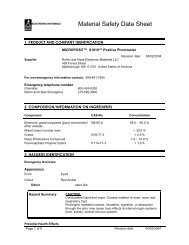sec-BUTYL ALCOHOL
sec-BUTYL ALCOHOL
sec-BUTYL ALCOHOL
Create successful ePaper yourself
Turn your PDF publications into a flip-book with our unique Google optimized e-Paper software.
MSDS Number: B6302 * * * * * Effective Date: 11/10/05 * * * * * Supercedes: 02/18/03<br />
<strong>sec</strong>-<strong>BUTYL</strong> <strong>ALCOHOL</strong><br />
1. Product Identification<br />
Synonyms: 2-Butanol; S-butyl alcohol; methyl ethyl carbinol; 1-methyl<br />
propanol<br />
CAS No.: 78-92-2<br />
Molecular Weight: 74.12<br />
Chemical Formula: CH3CHOHCH2CH3<br />
Product Codes:<br />
J.T. Baker: D721<br />
Mallinckrodt: 1821<br />
2. Composition/Information on Ingredients<br />
Ingredient CAS No Percent<br />
Hazardous<br />
--------------------------------------- ------------ ------------<br />
---------<br />
<strong>sec</strong>-Butyl Alcohol 78-92-2 100%<br />
Yes
3. Hazards Identification<br />
Emergency Overview<br />
--------------------------<br />
WARNING! FLAMMABLE LIQUID AND VAPOR. HARMFUL IF<br />
SWALLOWED OR INHALED. CAUSES IRRITATION TO SKIN,<br />
EYES AND RESPIRATORY TRACT. AFFECTS CENTRAL<br />
NERVOUS SYSTEM.<br />
Potential Health Effects<br />
----------------------------------<br />
Inhalation:<br />
Inhalation of concentrated vapors may cause headache, dizziness, and<br />
drowsiness. Causes irritation to the respiratory tract. Symptoms can<br />
include sore throat, cough.<br />
Ingestion:<br />
Ingestion may cause sore throat, headache, dizziness, and drowsiness.<br />
Skin Contact:<br />
Causes mild irritation. May cause allergic reaction in sensitive individuals.<br />
Eye Contact:<br />
Vapors may irritate the eyes; splashes will cause eye irritation with<br />
redness and pain.<br />
Chronic Exposure:<br />
Prolonged skin contact may result in drying and cracking of the skin.<br />
Aggravation of Pre-existing Conditions:<br />
Persons with pre-existing skin disorders or impaired liver, kidney, or<br />
pulmonary function may be more susceptible to the effects of this agent.<br />
4. First Aid Measures<br />
Inhalation:<br />
Remove to fresh air. If not breathing, give artificial respiration. If<br />
breathing is difficult, give oxygen. Call a physician.<br />
Ingestion:<br />
Give large amounts of water to drink. Never give anything by mouth to an<br />
unconscious person. Get medical attention.<br />
Skin Contact:<br />
Remove any contaminated clothing. Wash skin with soap or mild<br />
detergent and water for at least 15 minutes. Wash clothes before reuse. Get<br />
medical attention if irritation develops or persists.<br />
Eye Contact:<br />
Immediately flush eyes with plenty of water for at least 15 minutes, lifting<br />
lower and upper eyelids occasionally. Get medical attention immediately.
5. Fire Fighting Measures<br />
Fire:<br />
Flash point: 24C (75F) CC<br />
Autoignition temperature: 405C (761F)<br />
Flammable limits in air % by volume:<br />
lel: 1.7; uel: 9.8<br />
Flammable liquid and vapor!<br />
( uel @ 100C )<br />
Explosion:<br />
Above flash point, vapor-air mixtures are explosive within flammable<br />
limits noted above. Sensitive to static discharge.<br />
Fire Extinguishing Media:<br />
Dry chemical, alcohol foam or carbon dioxide. Water may be ineffective.<br />
Water spray may be used to keep fire exposed containers cool.<br />
Special Information:<br />
In the event of a fire, wear full protective clothing and NIOSH-approved<br />
self-contained breathing apparatus with full facepiece operated in the<br />
pressure demand or other positive pressure mode.<br />
6. Accidental Release Measures<br />
Ventilate area of leak or spill. Remove all sources of ignition. Wear<br />
appropriate personal protective equipment as specified in Section 8.<br />
Isolate hazard area. Keep unnecessary and unprotected personnel from<br />
entering. Contain and recover liquid when possible. Use non-sparking<br />
tools and equipment. Collect liquid in an appropriate container or absorb<br />
with an inert material (e. g., vermiculite, dry sand, earth), and place in a<br />
chemical waste container. Do not use combustible materials, such as saw<br />
dust. Do not flush to sewer! If a leak or spill has not ignited, use water<br />
spray to disperse the vapors, to protect personnel attempting to stop leak,<br />
and to flush spills away from exposures.<br />
7. Handling and Storage<br />
Protect against physical damage. Store in a cool, dry well-ventilated<br />
location, away from any area where the fire hazard may be acute. Outside<br />
or detached storage is preferred. Separate from incompatibles. Containers<br />
should be bonded and grounded for transfers to avoid static sparks.
Storage and use areas should be No Smoking areas. Use non-sparking type<br />
tools and equipment, including explosion proof ventilation. Containers of<br />
this material may be hazardous when empty since they retain product<br />
residues (vapors, liquid); observe all warnings and precautions listed for<br />
the product.<br />
8. Exposure Controls/Personal Protection<br />
Airborne Exposure Limits:<br />
-OSHA Permissible Exposure Limit (PEL):<br />
150 ppm (TWA)<br />
-ACGIH Threshold Limit Value (TLV):<br />
100 ppm (TWA)<br />
Ventilation System:<br />
A system of local and/or general exhaust is recommended to keep<br />
employee exposures below the Airborne Exposure Limits. Local exhaust<br />
ventilation is generally preferred because it can control the emissions of<br />
the contaminant at its source, preventing dispersion of it into the general<br />
work area. Please refer to the ACGIH document, Industrial Ventilation, A<br />
Manual of Recommended Practices, most recent edition, for details.<br />
Personal Respirators (NIOSH Approved):<br />
If the exposure limit is exceeded and engineering controls are not feasible,<br />
a full facepiece respirator with organic vapor cartridge may be worn up to<br />
50 times the exposure limit or the maximum use concentration specified<br />
by the appropriate regulatory agency or respirator supplier, whichever is<br />
lowest. For emergencies or instances where the exposure levels are not<br />
known, use a full-facepiece positive-pressure, air-supplied respirator.<br />
WARNING: Air purifying respirators do not protect workers in oxygendeficient<br />
atmospheres.<br />
Skin Protection:<br />
Wear impervious protective clothing, including boots, gloves, lab coat,<br />
apron or coveralls, as appropriate, to prevent skin contact.<br />
Eye Protection:<br />
Use chemical safety goggles and/or a full face shield where splashing is<br />
possible. Maintain eye wash fountain and quick-drench facilities in work<br />
area.<br />
Other Control Measures:<br />
There is insufficient data in the published literature to assign complete<br />
numerical SAF-T-DATA* ratings and laboratory protective equipment for<br />
this product. Special precautions must be used in storage, use and<br />
handling. Protective equipment for laboratory bench use should be chosen<br />
using professional judgment based on the size and type of reaction or test<br />
to be conducted and the available ventilation, with overriding<br />
consideration to minimize contact with the chemical.
9. Physical and Chemical Properties<br />
Appearance:<br />
Clear, colorless liquid.<br />
Odor:<br />
Strong pleasant odor.<br />
Solubility:<br />
15g/100g water @ 20C (68F).<br />
Density:<br />
0.81 @ 20C/4C<br />
pH:<br />
No information found.<br />
% Volatiles by volume @ 21C (70F):<br />
100<br />
Boiling Point:<br />
94C (201F)<br />
Melting Point:<br />
-115C (-175F)<br />
Vapor Density (Air=1):<br />
2.6<br />
Vapor Pressure (mm Hg):<br />
13 @ 20C (68F)<br />
Evaporation Rate (BuAc=1):<br />
1.3<br />
10. Stability and Reactivity<br />
Stability:<br />
Stable under ordinary conditions of use and storage.<br />
Hazardous Decomposition Products:<br />
Carbon dioxide and carbon monoxide may form when heated to<br />
decomposition.<br />
Hazardous Polymerization:<br />
Will not occur.<br />
Incompatibilities:<br />
Acids, acid chlorides, acid anhydrides, organic peroxides, chromium<br />
trioxide, oxidizing agents and halogens.<br />
Conditions to Avoid:<br />
Heat, flames, ignition sources and incompatibles.
11. Toxicological Information<br />
Oral rat LD50: 6480 mg/kg; Irritation data: eye, rabbit: 100mg/24H<br />
Moderate; Investigated as a reproductive effector.<br />
--------\Cancer Lists\-----------------------------------------------<br />
-------<br />
---NTP Carcinogen---<br />
Ingredient Known Anticipated IARC<br />
Category<br />
------------------------------------ ----- ----------- ------<br />
------<strong>sec</strong>-Butyl<br />
Alcohol (78-92-2) No No<br />
None<br />
12. Ecological Information<br />
Environmental Fate:<br />
When released into the soil, this material is expected to readily<br />
biodegrade. When released into the soil, this material is expected to leach<br />
into groundwater. When released into the soil, this material is expected to<br />
quickly evaporate. When released into water, this material is expected to<br />
readily biodegrade. When released to water, this material is expected to<br />
quickly evaporate. When released into the water, this material is expected<br />
to have a half-life between 1 and 10 days. This material is not expected to<br />
significantly bioaccumulate. This material has an estimated<br />
bioconcentration factor (BCF) of less than 100. This material has a log<br />
octanol-water partition coefficient of less than 3.0. When released into the<br />
air, this material is expected to be readily degraded by reaction with<br />
photochemically produced hydroxyl radicals. When released into the air,<br />
this material is not expected to be degraded by photolysis. When released<br />
into the air, this material is expected to be readily removed from the<br />
atmosphere by wet deposition. When released into the air, this material is<br />
expected to have a half-life between 1 and 10 days.<br />
Environmental Toxicity:<br />
The LC50/96-hour values for fish are over 100 mg/l. This material is not<br />
expected to be toxic to aquatic life.<br />
13. Disposal Considerations<br />
Whatever cannot be saved for recovery or recycling should be handled as<br />
hazardous waste and sent to a RCRA approved incinerator or disposed in a<br />
RCRA approved waste facility. Processing, use or contamination of this<br />
product may change the waste management options. State and local
disposal regulations may differ from federal disposal regulations. Dispose<br />
of container and unused contents in accordance with federal, state and<br />
local requirements.<br />
14. Transport Information<br />
Domestic (Land, D.O.T.)<br />
-----------------------<br />
Proper Shipping Name: BUTANOLS<br />
Hazard Class: 3<br />
UN/NA: UN1120<br />
Packing Group: II<br />
Information reported for product/size: 20L<br />
International (Water, I.M.O.)<br />
-----------------------------<br />
Proper Shipping Name: BUTANOLS<br />
Hazard Class: 3<br />
UN/NA: UN1120<br />
Packing Group: II<br />
Information reported for product/size: 20L<br />
15. Regulatory Information<br />
--------\Chemical Inventory Status - Part 1\-------------------------<br />
--------<br />
Ingredient TSCA EC Japan<br />
Australia<br />
----------------------------------------------- ---- --- ----- --<br />
------<strong>sec</strong>-Butyl<br />
Alcohol (78-92-2) Yes Yes Yes<br />
Yes<br />
--------\Chemical Inventory Status - Part 2\-------------------------<br />
--------<br />
--Canada--<br />
Ingredient Korea DSL NDSL<br />
Phil.<br />
----------------------------------------------- ----- --- ---- -<br />
---<strong>sec</strong>-Butyl<br />
Alcohol (78-92-2) Yes Yes No<br />
Yes<br />
--------\Federal, State & International Regulations - Part 1\--------<br />
--------
-SARA 302- ------SARA<br />
313------<br />
Ingredient<br />
Chemical Catg.<br />
RQ TPQ List<br />
----------------------------------------- ---<br />
--------<br />
----- ---- -----<strong>sec</strong>-Butyl<br />
Alcohol (78-92-2) No No Yes<br />
No<br />
--------\Federal, State & International Regulations - Part 2\--------<br />
--------<br />
-RCRA- -<br />
TSCA-<br />
Ingredient CERCLA 261.33 8(d)<br />
----------------------------------------- ------ ------ -----<br />
-<br />
<strong>sec</strong>-Butyl Alcohol (78-92-2) No No Yes<br />
Chemical Weapons Convention: No TSCA 12(b): No CDTA: No<br />
SARA 311/312: Acute: Yes Chronic: Yes Fire: Yes Pressure: No<br />
Reactivity: No (Pure / Liquid)<br />
Australian Hazchem Code: 3[Y]E<br />
Poison Schedule: None allocated.<br />
WHMIS:<br />
This MSDS has been prepared according to the hazard criteria of the<br />
Controlled Products Regulations (CPR) and the MSDS contains all of the<br />
information required by the CPR.<br />
16. Other Information<br />
NFPA Ratings: Health: 1 Flammability: 3 Reactivity: 0<br />
Label Hazard Warning:<br />
WARNING! FLAMMABLE LIQUID AND VAPOR. HARMFUL IF<br />
SWALLOWED OR INHALED. CAUSES IRRITATION TO SKIN,<br />
EYES AND RESPIRATORY TRACT. AFFECTS CENTRAL<br />
NERVOUS SYSTEM.<br />
Label Precautions:<br />
No SAF-T-DATA Ratings have been developed for this product. Read and<br />
follow all warnings, precautions, instructions and other safety and<br />
handling information on the label and MSDS.<br />
Keep away from heat, sparks and flame.<br />
Keep container closed.<br />
Use with adequate ventilation.<br />
Avoid breathing vapor.<br />
Wash thoroughly after handling.
Avoid contact with eyes, skin and clothing.<br />
Label First Aid:<br />
If inhaled, remove to fresh air. If not breathing, give artificial respiration.<br />
If breathing is difficult, give oxygen. Call a physician. In case of contact,<br />
immediately flush skin or eyes with plenty of water for at least 15 minutes.<br />
Call a physician if irritation develops or persists. If swallowed, give large<br />
amounts of water to drink. Never give anything by mouth to an<br />
unconscious person. Call a physician.<br />
Product Use:<br />
Laboratory Reagent.<br />
Revision Information:<br />
No Changes.<br />
Disclaimer:<br />
************************************************************<br />
************************************<br />
Mallinckrodt Baker, Inc. provides the information contained herein in<br />
good faith but makes no representation as to its comprehensiveness or<br />
accuracy. This document is intended only as a guide to the<br />
appropriate precautionary handling of the material by a properly<br />
trained person using this product. Individuals receiving the<br />
information must exercise their independent judgment in determining<br />
its appropriateness for a particular purpose. MALLINCKRODT<br />
BAKER, INC. MAKES NO REPRESENTATIONS OR<br />
WARRANTIES, EITHER EXPRESS OR IMPLIED, INCLUDING<br />
WITHOUT LIMITATION ANY WARRANTIES OF<br />
MERCHANTABILITY, FITNESS FOR A PARTICULAR<br />
PURPOSE WITH RESPECT TO THE INFORMATION SET<br />
FORTH HEREIN OR THE PRODUCT TO WHICH THE<br />
INFORMATION REFERS. ACCORDINGLY, MALLINCKRODT<br />
BAKER, INC. WILL NOT BE RESPONSIBLE FOR DAMAGES<br />
RESULTING FROM USE OF OR RELIANCE UPON THIS<br />
INFORMATION.<br />
************************************************************<br />
************************************<br />
Prepared by: Environmental Health & Safety<br />
Phone Number: (314) 654-1600 (U.S.A.)


